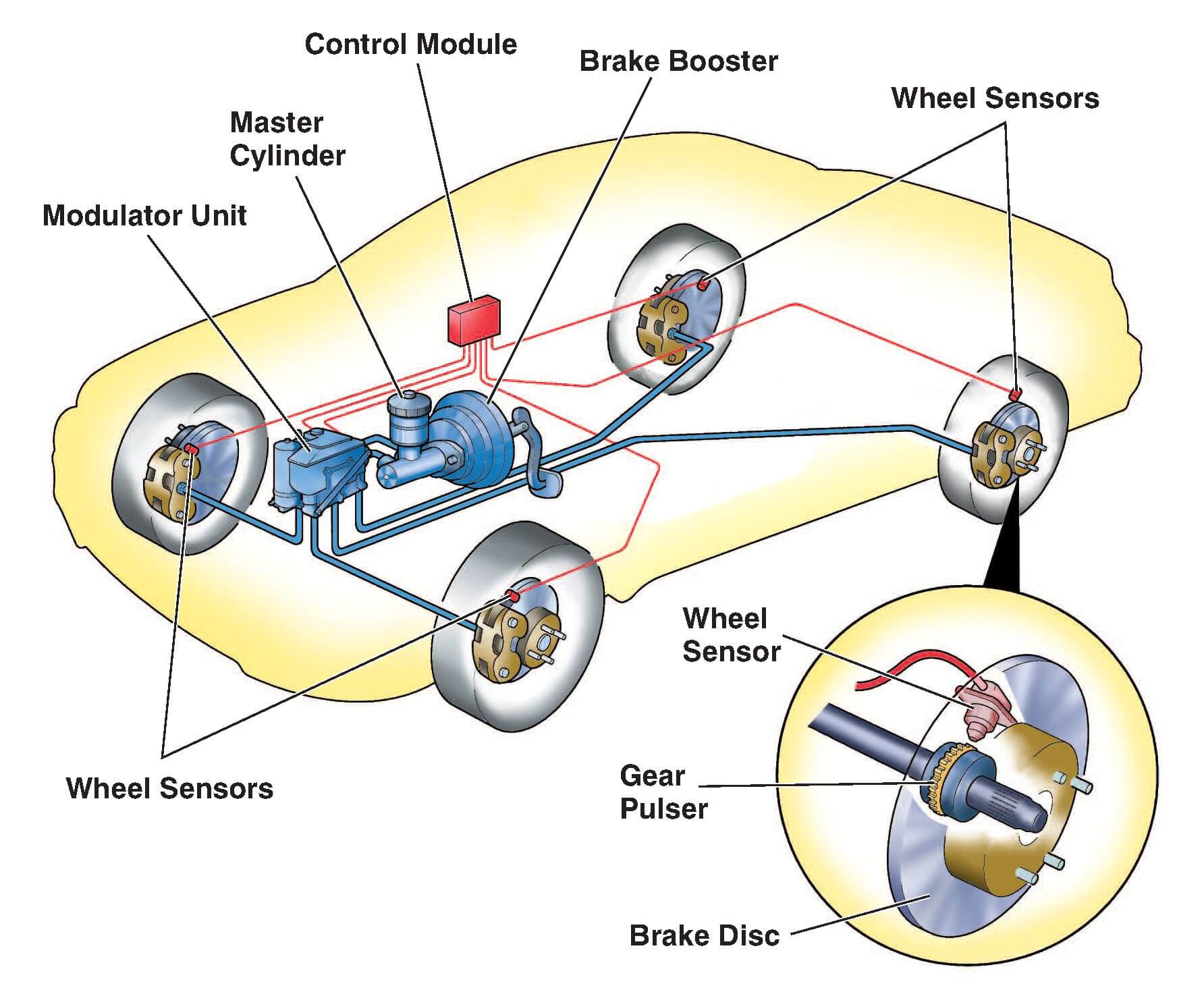Understanding the Anti-Lock Braking System (ABS) in Vehicles
1. Introduction to Anti-Lock Braking System
What is ABS?
The Anti-Lock Braking System (ABS) is a safety mechanism installed in vehicles to prevent the wheels from locking up when the brakes are applied. It utilizes speed sensors to detect the rotation of each wheel and modulates the brake pressure to avoid wheel lock-up. By doing so, ABS enables the driver to maintain steering control and prevent skidding, especially on slippery surfaces.
How does ABS work?
When the driver applies the brakes, the ABS control module constantly monitors the speed of each wheel. If the system detects a wheel about to lock up, it rapidly modulates the brake pressure by releasing and reapplying the brakes. This pulsating action prevents the wheel from completely locking up, allowing the driver to maintain control and steer the vehicle effectively. ABS also ensures that the braking force is distributed evenly among all the wheels, contributing to better stability and control.
2. Benefits of ABS in Vehicles
Prevention of wheel lock-up
One of the primary advantages of ABS is its ability to prevent wheel lock-up during braking. When a wheel locks up, it loses traction with the road surface, leading to skidding and a loss of control. ABS intervenes by rapidly adjusting the brake pressure to each wheel, ensuring that they continue rotating and maintain traction. This feature significantly reduces the likelihood of accidents caused by wheel lock-up, especially in emergency situations.
Improved vehicle control
By preventing wheel lock-up, ABS enhances the overall control of the vehicle during braking. The driver can steer the vehicle in the desired direction while applying the brakes, even on slippery surfaces. This improved control allows for better maneuverability and reduces the risk of collisions or accidents caused by unexpected obstacles.
Reduced stopping distance
ABS plays a crucial role in reducing the stopping distance of a vehicle, particularly on slippery or wet surfaces. By preventing wheel lock-up, the braking distance is optimized, enabling the vehicle to come to a complete stop in a shorter span of time. This benefit is particularly valuable in emergency situations, where a shorter stopping distance can be the difference between a near-miss and a collision.
Enhanced performance on slippery surfaces
Slippery surfaces pose a significant challenge to drivers, as they increase the risk of skidding and loss of control. ABS greatly improves a vehicle’s performance on such surfaces by preventing wheel lock-up and maintaining traction. The pulsating action of ABS helps the driver maintain stability and control, even in adverse weather conditions or on slippery roads.
3. The Role of ABS in Car Insurance
Lower insurance premiums
Car insurance is essential for financial protection in case of accidents or mishaps. Insurance companies consider several factors when calculating premiums, including the safety features installed in the vehicle. ABS is considered a significant safety feature that reduces the risk of accidents, and insurers often offer lower annual premiums to vehicle owners who have ABS-equipped vehicles. This incentivizes car owners to prioritize safety and install ABS in their vehicles.
Incentives for installing ABS
Apart from lower premiums, insurance providers may offer additional incentives for installing ABS in vehicles. These incentives can range from special discounts on premiums to favorable terms and conditions. It is recommended to inquire with insurance providers about the specific incentives offered for ABS installation to maximize the benefits of having this safety feature in your vehicle.
4. Choosing the Right Vehicle with ABS
Considering ABS as a safety feature
When purchasing a new vehicle, it is crucial to consider ABS as a vital safety feature. ABS significantly enhances the safety and control of the vehicle during braking, making it an essential feature, especially in regions with challenging road conditions or adverse weather. Prioritizing ABS in your vehicle selection process ensures that you are investing in the safety of yourself, your passengers, and others on the road.
Researching ABS-equipped vehicles
Before making a final decision on a vehicle, it is recommended to research the availability of ABS in different models and manufacturers. Many reputable car manufacturers prioritize safety and offer ABS as a standard feature or as an optional upgrade. By comparing different models and their ABS capabilities, you can make an informed decision based on your safety requirements and budget.
5. Maintenance and Care for ABS
Regular inspection and servicing
To ensure the optimal functioning of ABS, it is essential to include it as part of your regular vehicle inspection and servicing routine. During routine maintenance, qualified technicians can check the ABS sensors, hydraulic components, and control module for any signs of wear or malfunction. Regular inspections help identify potential issues early on and prevent ABS-related problems from compromising your vehicle’s safety.
Understanding warning signs
As a responsible vehicle owner, it is crucial to be aware of the warning signs that indicate potential issues with your ABS. Any illuminated warning lights or irregularities in the brake system’s performance should not be ignored. If you notice any unusual behavior while braking, such as pulsating brakes or a vibrating brake pedal, it is advisable to have your ABS system inspected by a professional technician.
6. Other Advanced Braking Systems
Traction Control System (TCS)
The Traction Control System (TCS) works in tandem with ABS to improve vehicle stability and control. TCS uses various sensors to monitor wheel rotation and intervenes when it detects excessive wheel spin, especially during acceleration. By reducing engine power or applying brake pressure to specific wheels, TCS helps maintain traction and prevents the wheels from slipping or skidding.
Electronic Stability Control (ESC)
Electronic Stability Control (ESC) is an advanced safety feature that further enhances the vehicle’s stability and control. It utilizes various sensors to monitor the vehicle’s movement, including steering input, yaw rate, and wheel speed. If the system detects a loss of control, ESC intervenes by selectively applying the brakes to specific wheels and adjusting engine power to help the driver regain control.
Brake Assist System (BAS)
The Brake Assist System (BAS) is designed to assist the driver in emergency braking situations. When the driver applies the brakes suddenly and forcefully, BAS detects the severity of the braking and applies maximum brake pressure to ensure the shortest possible stopping distance. BAS can significantly reduce the risk of accidents by providing additional braking force in critical situations.
Electronic Brakeforce Distribution (EBD)
Electronic Brakeforce Distribution (EBD) is a system that optimizes the distribution of braking force among the wheels. It takes into account various factors such as vehicle weight distribution, road conditions, and individual wheel traction. By adjusting the brake pressure to each wheel, EBD improves stability and control during braking, further enhancing the effectiveness of ABS.
7. ABS in Different Types of Vehicles
Passenger cars
ABS is commonly found in passenger cars, as it significantly improves their safety and handling capabilities. Whether it’s a compact car, sedan, or luxury vehicle, ABS ensures that the driver can maintain control during braking and reduces the risk of accidents caused by wheel lock-up. When purchasing a passenger car, it is highly recommended to prioritize ABS as a crucial safety feature.
Two-wheelers
While ABS was initially introduced in cars, it has now become increasingly prevalent in two-wheelers as well. Motorcycles and scooters equipped with ABS offer enhanced safety, especially during sudden braking or on slippery surfaces. ABS in two-wheelers prevents wheel lock-up and allows the rider to maintain better control, reducing the risk of skidding or losing balance.
Commercial vehicles
ABS is equally important in commercial vehicles, such as trucks and buses. These vehicles often carry heavy loads and have different handling characteristics compared to passenger cars. ABS enables commercial vehicle drivers to maintain control and stability during braking, reducing the risk of accidents caused by wheel lock-up or skidding. The safety of the driver, passengers, and cargo is significantly enhanced with the presence of ABS.
Off-road vehicles
Off-road vehicles, including SUVs and 4x4s, can greatly benefit from ABS, especially during challenging off-road conditions. ABS prevents wheel lock-up on uneven terrain, allowing the driver to maintain control and maneuverability. This safety feature is particularly valuable in off-road scenarios where sudden braking or unexpected obstacles can pose a significant risk.
8. ABS and Road Safety
Impact on accident prevention
The installation of ABS has played a significant role in preventing accidents and reducing their severity. By preventing wheel lock-up and maintaining control, ABS helps drivers avoid collisions with other vehicles or obstacles. The ability to steer while braking greatly increases the chances of evading potential accidents, protecting both the driver and other road users.
Significance in reducing fatalities
ABS has been instrumental in reducing fatalities resulting from road accidents. By preventing wheel lock-up and skidding, ABS significantly improves the driver’s control over the vehicle, reducing the likelihood of accidents with fatal consequences. The implementation of ABS as a standard safety feature in vehicles has contributed to saving countless lives on the road.
Importance for safe driving practices
While ABS is a remarkable safety feature, it is crucial to remember that safe driving practices are equally important. ABS should never be relied upon as a substitute for responsible driving habits. Maintaining a safe distance from other vehicles, adhering to speed limits, and being aware of road conditions are essential elements of safe driving that should be followed in conjunction with ABS.
9. Future Developments in ABS Technology
Integration with autonomous vehicles
As the automotive industry progresses towards autonomous vehicles, the integration of ABS technology becomes even more critical. ABS plays a vital role in enhancing the safety of autonomous vehicles by ensuring optimal braking performance and control. The ongoing advancements in ABS technology will continue to support the development and implementation of autonomous driving systems.
Improvements in sensor technology
ABS relies on accurate and reliable sensor data to function effectively. The continuous advancements in sensor technology, such as wheel speed sensors and accelerometers, contribute to the overall performance and precision of ABS. As sensor technology evolves, ABS systems will become more sophisticated, enabling even better control and safety during braking.
10. Conclusion
In conclusion, the Anti-Lock Braking System (ABS) is a crucial safety feature that enhances vehicle control, prevents wheel lock-up, and reduces the risk of accidents. ABS significantly improves the overall safety of vehicles, making them more maneuverable and responsive during braking, especially on slippery surfaces. Its role in car insurance cannot be overlooked, as it often results in lower premiums and additional incentives for vehicle owners. By prioritizing ABS and staying informed about its maintenance and care, we can ensure safer journeys on the road. As technology continues to advance, ABS will remain a vital component in promoting road safety and reducing accidents, ultimately saving lives.




